A missing finger changes life in big ways. Holding a glass, typing a message, or tying a shoelace—suddenly, these everyday things become tough. But what if your prosthetic finger could think with you? What if it could learn your grip and adjust on its own?
That’s what artificial intelligence (AI) is doing for finger prosthetics. It’s turning static tools into smart helpers.
In this article, we’ll explore how AI is reshaping finger prosthetics—from better control and real-time response to more comfort and even a sense of touch. This is not the future. It’s happening right now, and it’s helping real people live fuller lives.
Understanding AI in Finger Prosthetics
What Exactly Is AI?
AI stands for artificial intelligence. It’s not a robot or a machine on its own. It’s a system that helps machines “learn” from patterns and make smart decisions.
In finger prosthetics, AI is like a silent partner. It watches, listens, and adapts. It helps the prosthetic understand your muscle movements better. Over time, it starts to know what you’re trying to do—even before you finish doing it.
This turns the prosthetic from a basic tool into something that almost feels like part of you.
How AI Reads Human Intent
Your body talks in signals. When you try to move your hand, your brain sends tiny electric pulses to your muscles. These are called myoelectric signals.
AI doesn’t just read these signals. It studies them.
It figures out what each pattern means. A tight squeeze? A gentle touch? A twist of the wrist? AI learns your personal way of moving.
That means fewer errors and faster responses. You don’t have to think twice before picking something up. Your prosthetic just knows.
From Movement to Meaning
Old prosthetics could only do what you told them—open, close, hold. But they didn’t really “understand” what was happening.
With AI, movement has meaning.
If you’re holding a delicate egg, the AI senses that you’re applying just a little pressure. If you’re picking up a heavy book, it knows to increase the grip.
AI adds smart layers between your signal and the prosthetic’s action. It helps match your intention with the real-world task in front of you.
AI Doesn’t Replace You—It Works With You
Some people worry AI will take over. But in prosthetics, it’s the opposite.
AI is a helper. It doesn’t act on its own. It listens to you. It watches how you move, how fast you move, and even how often you repeat something.
The more you use your prosthetic finger, the better the AI gets at supporting your natural rhythm. It becomes more responsive. More personal.
It’s like having a finger that learns alongside you.
How AI Makes Finger Prosthetics Smarter
Learning from Daily Life
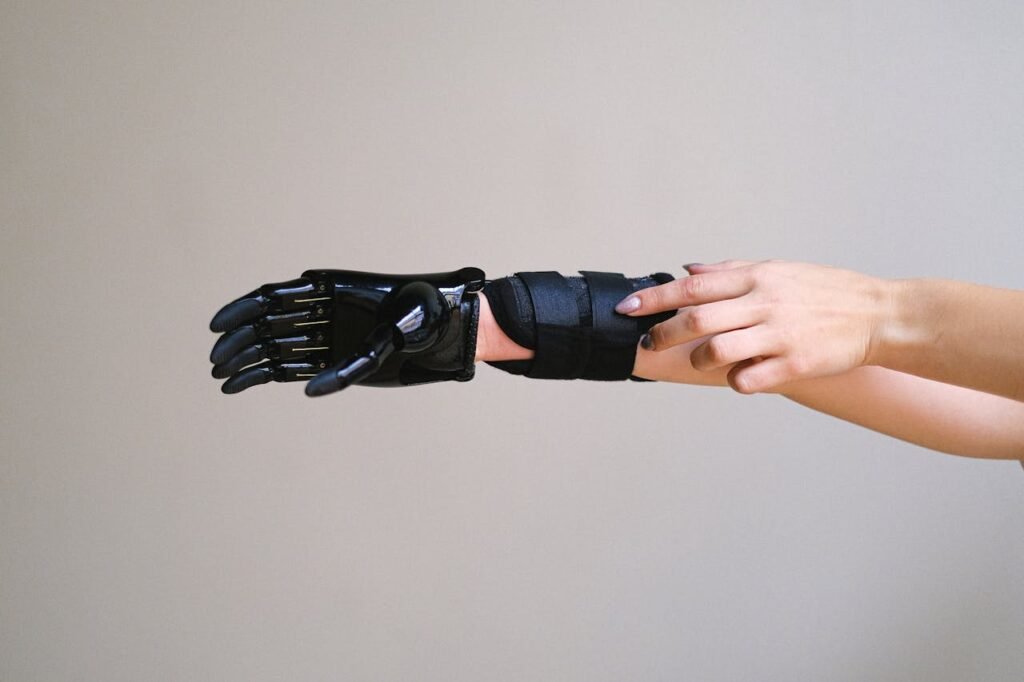
Imagine teaching someone how you like your tea—how much sugar, how hot, how strong. At first, they might get it wrong. But the more they watch you, the better they get.
AI works in a similar way.
When you first start using a prosthetic finger with AI, it doesn’t know you yet. But each time you grip something, the AI listens. It tracks how strong you squeeze, how fast you move, and what kind of shape your hand is in.
It watches for patterns. Do you always use a certain grip when you pick up a pen? Do you use more force when lifting a bag? Do you hold your toothbrush a certain way?
Over time, the AI builds a library of your habits. It learns what “normal” feels like for you. And then it starts to act faster—giving you the right grip without you needing to think about it.
This means you can go through your day with less effort. The prosthetic begins to feel natural—like it’s a part of you, not just something you wear.
Real-Time Response, No More Guessing
One of the biggest frustrations with older prosthetics is the delay. You think about holding something, but the device is slow or reacts in a way you didn’t expect.
AI helps solve this.
Modern AI systems in prosthetics can process your muscle signals in milliseconds. That means when you send a signal, the prosthetic reacts instantly—just like your real finger would have.
This real-time response is not just about speed. It’s about confidence. You don’t have to second-guess every move. You can reach for a glass or a phone knowing your prosthetic will behave just as you want it to.
And when you feel in control, everything changes. You stop being careful. You start being free.
Adapting to Changes in Your Body
Our bodies are always changing. Some days, you’re tired. Your muscles don’t fire the same way. Maybe your arm is sore. Maybe it’s hot and sweaty. Maybe you gained or lost a little weight.
Older prosthetics would struggle with this. They were tuned to one kind of signal, one kind of fit. Anything different caused trouble.
AI makes prosthetics smarter because it’s flexible. It doesn’t need your signals to be perfect. It learns the range of what “normal” means for you.
If your signals change slightly—because of weather, fatigue, or anything else—the AI can still understand them. It adjusts, adapts, and keeps working.
This means fewer breakdowns, fewer misreads, and a smoother experience overall. It keeps up with you, no matter what.
Predicting What You’ll Do Next
AI can also predict what you’re about to do.
This doesn’t mean it reads your mind. But it does learn your patterns.
If you’re picking up a spoon, it knows that after gripping, you’ll likely want to rotate your wrist. If you’re reaching for your shirt buttons, it knows you’ll use a pinching motion.
By reading the beginning of your movement, the AI can get a head start on the next one. This makes actions feel smoother, faster, and more natural.
It’s a small change, but it makes a big difference in how comfortable and fluid your day feels.
Giving Feedback That Feels Real
Holding something isn’t just about movement. It’s also about feeling.
Your real fingers give you tiny signals—like how much pressure you’re using, whether something is hot or cold, or if you’re about to drop it.
Most prosthetics can’t do that. You have to rely on your eyes. That’s tiring. It breaks your focus. It reminds you that the hand isn’t really yours.
AI is helping change this by working with smart sensors and feedback systems. These sensors feel pressure, texture, and even motion. They send that data back to the AI.
Then, the AI turns it into feedback for you—often through small vibrations or signals. It can tap you gently to say, “You’re squeezing too hard.” Or vibrate slightly when you make contact with an object.
This kind of feedback brings your brain back into the loop. It makes you more connected to the object you’re touching. You stop looking. You start feeling.
And that’s a huge step toward making prosthetics feel alive.
Making Learning Easier with AI
Using a new prosthetic can be scary. It’s like learning to walk all over again—but with your hands.
AI is making that easier, too.
When you start training with a smart prosthetic, the AI adjusts its sensitivity to match your comfort level. If you’re new, it slows things down. It responds gently. It gives you space to learn.
As you improve, the AI opens up more features. It becomes quicker, stronger, and more capable. But it always moves at your pace.
This makes rehab less frustrating. Instead of fighting the device, you grow with it. And because the AI is learning from you, your training sessions don’t get lost. Every hour you practice helps build a better bond between you and your prosthetic.
AI Doesn’t Need an Internet Connection
Many people wonder if AI means their prosthetic needs to stay connected to Wi-Fi or a phone.
But that’s not the case.
Most AI in prosthetics works offline, inside the device itself. It doesn’t send your data anywhere. It doesn’t need a cloud connection to function.
This means it works anywhere—in your village, in the field, in the classroom, even without mobile coverage.
It also protects your privacy. Everything it learns about you stays inside your hand. No one else sees it.
This kind of AI is called “on-device learning.” It’s small, fast, private, and safe. And it’s the future of smart healthcare tools—not just in India, but around the world.
Challenges AI Still Faces in Finger Prosthetics
Understanding Every User Is Different
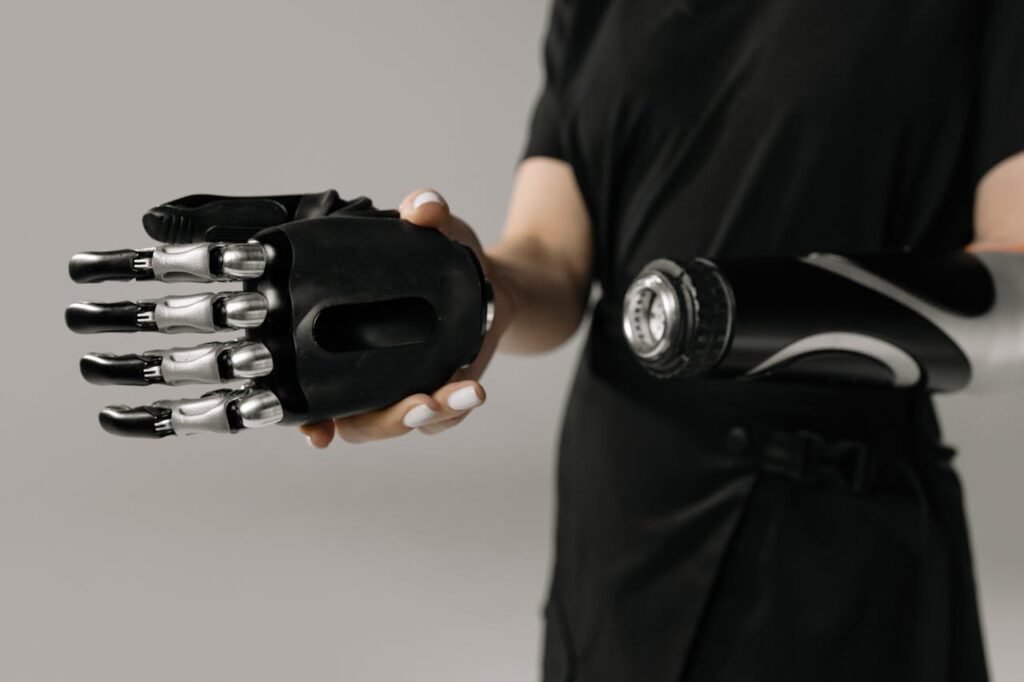
AI learns from patterns. But not every person sends the same kind of signal.
Some users have strong, clear muscle signals. Others may have weak or noisy signals, especially if they’ve had an amputation for a long time.
This makes it harder for AI to understand what the person is trying to do.
That’s one of the biggest challenges: creating an AI that can handle a wide range of users—young or old, new or experienced, strong or weak—without needing hours of calibration.
Current systems are getting better, but we’re not fully there yet. It takes time to fine-tune the device so it understands you.
Too Many Signals, Not Enough Meaning
Your body doesn’t just send one signal—it sends hundreds at once. Muscles fire, skin stretches, joints move.
For an AI system, that’s a lot to take in.
Sometimes, too much data can confuse the prosthetic. It might react in the wrong way or freeze up because it doesn’t know which signal to trust.
Designers are now working on smarter filters—AI that can separate the important signals from the noise. That way, the prosthetic only acts on what really matters.
This makes it more reliable, especially in busy or stressful situations.
Power and Processing in a Small Package
AI needs a processor—a chip that does all the thinking. But prosthetic fingers are small. They don’t have room for big computers or heavy batteries.
This means the AI has to be super-efficient. It has to run fast, on low power, without heating up or draining the battery too quickly.
That’s a tough ask.
Engineers are constantly working to shrink the technology. New microchips, energy-saving circuits, and better software all help—but we still have limits.
Making powerful AI that fits into a device the size of a finger is a real challenge. And it’s one of the key areas of research today.
Cost and Accessibility
AI-powered prosthetics are amazing. But they can be expensive to make.
While Robobionics works hard to keep costs down, adding AI features—like smart sensors, feedback motors, and fast processors—can still push the price up.
In India and other developing countries, this can be a big barrier. We want the best tech, but we also want it to be affordable.
The goal is to bring these smart features to everyone, not just a few. That means using local materials, smart design, and clever software to do more with less.
It’s a challenge we’re committed to solving.
The Role of Robobionics in AI-Powered Prosthetics
Building with Purpose
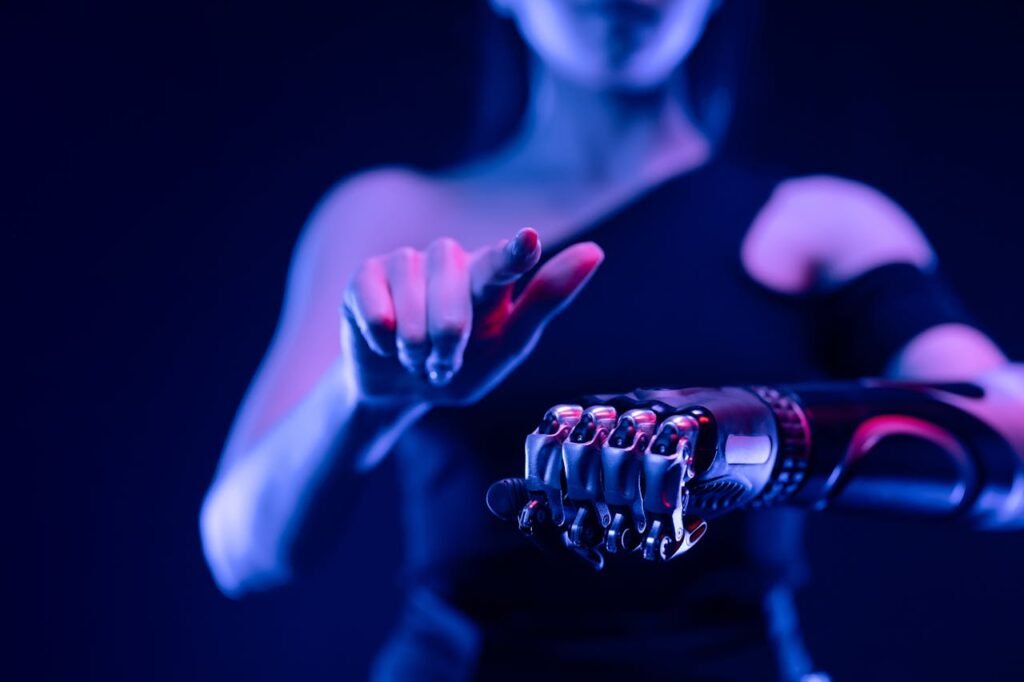
At Robobionics, we don’t just build prosthetics. We build tools that change lives.
We started with a mission—to make advanced prosthetics that are affordable, reliable, and designed for real people.
And now, we’re leading the charge in AI-powered prosthetics in India.
We’re not doing it for awards or attention. We’re doing it for the farmer who wants to hold his tools again. For the mother who wants to hold her baby with both hands. For the student who wants to write an exam without help.
Grippy Mech Finger: Ready for the Next Leap
Our Grippy Mech Finger already delivers powerful performance using mechanical design. But we’re not stopping there.
We’re working on next-gen models that will include AI-based control systems.
These models will adapt to your muscle signals, predict your grip, and provide smart feedback through gentle vibration—powered by our unique Sense of Touch™ tech.
This means your prosthetic will not just respond—it will understand.
It will feel more natural. More human.
And most importantly, it will feel like it belongs to you.
Built in India, Built for India
Most AI prosthetics in the world are imported. They’re expensive. They’re built for different climates, different users, and different lifestyles.
That’s why they often fail here.
Robobionics makes prosthetics that work for the Indian way of life—hot weather, long days, mixed-use tasks.
Our devices are sweat-proof, tough, and built for everyday use. And our AI systems are trained on real users from here—not just lab data from abroad.
That means when we say our AI understands you, we mean it.
A Future That Feels Closer
We believe the future of finger prosthetics isn’t far away. It’s already here—and it’s growing fast.
Every day, we test new ideas, collect new data, and improve our AI engines. Every week, we meet users who give us fresh insights. Every month, we roll out updates and improvements.
This is not a dream. It’s a living, breathing mission.
A smarter grip is not just ahead—it’s within reach.
AI and Personalization: One Hand, Many Lives
Why Personal Fit Matters More Than Ever
Every person uses their hand differently. A carpenter grips tools with force and precision. A teacher may rely on gestures and writing. A mother might need to cradle a baby, while a teenager wants to play the guitar. The challenge for prosthetic designers has always been to make a device that can support all these needs—without compromise. That’s where AI is stepping in to bridge the gap.
Artificial intelligence doesn’t just process muscle signals. It recognizes patterns unique to each individual. Over time, it learns how you move, what kind of pressure you use, and how you react to different situations. For example, if you use your prosthetic finger to zip up a jacket every morning, the AI will start to recognize that motion and help you do it more smoothly each day. It won’t require retraining or reprogramming—because it learns from you in real time.
The true beauty of this is how it turns one standard device into something deeply personal. You’re no longer adjusting yourself to the prosthetic; the prosthetic adjusts to you. Whether your grip style is soft and cautious or strong and quick, the AI adapts. This makes tasks easier, reduces frustration, and improves long-term satisfaction with the device.
More Than Movement: Emotional Comfort and Confidence
When people think of prosthetics, they usually think of function—gripping, lifting, holding. But there’s something deeper at play. The emotional connection users build with their device matters just as much. A prosthetic that understands your needs doesn’t just work better—it makes you feel more in control. That’s empowering.
Users have shared stories of how, for the first time since losing a limb, they could reach out and hold someone’s hand without fear of dropping or over-gripping. These little wins are huge. They restore dignity, confidence, and a sense of self.
This is where AI plays a quiet, but powerful, role. By making movements more fluid and intuitive, it takes the mental load off the user. Instead of thinking hard about each step, the prosthetic becomes second nature—like a real extension of the body. That’s not just better function. That’s healing.
The Road Ahead: Making AI in Prosthetics Better for Everyone
Training the AI with Local Lives in Mind
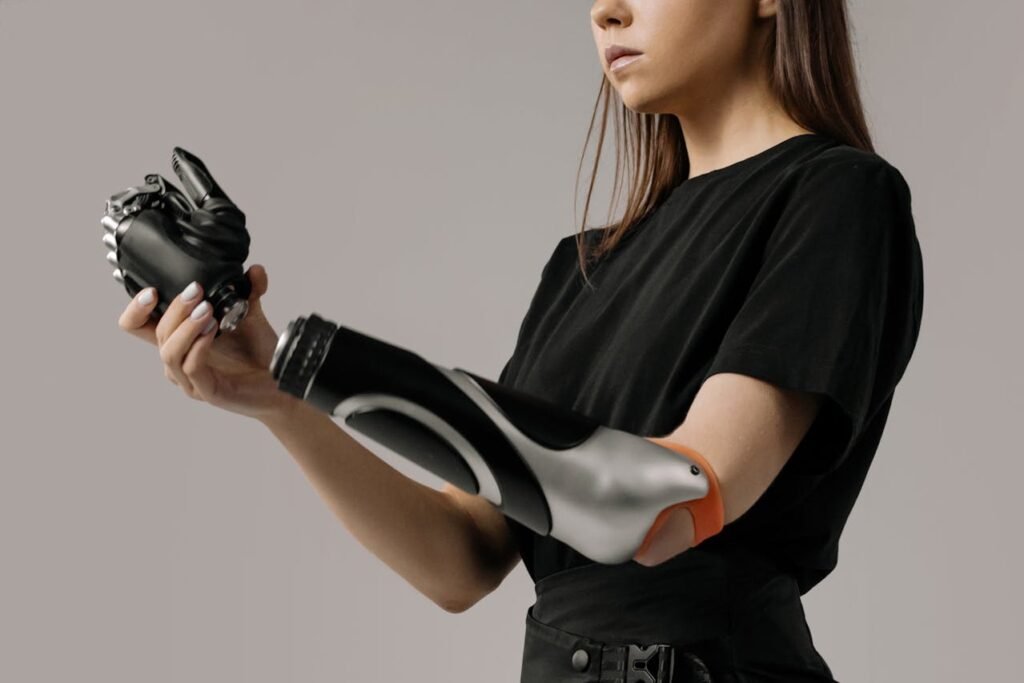
AI needs data to work well. But whose data? That’s the question more companies are now asking. If a system is trained only on data from users in the West—people with different muscle patterns, daily habits, or even body sizes—how can we expect it to perform well for users in India?
At Robobionics, we believe in local learning. Our AI systems are trained using data from Indian users—people with different diets, different physical routines, and different needs. Whether it’s a field worker gripping farming tools or a shopkeeper handling change, these daily actions inform our design and training models. This helps us build systems that are not only accurate but deeply relevant to real-life use here.
This local-first approach ensures that the AI inside our prosthetic fingers doesn’t just perform in theory—it performs in reality. That means fewer errors, quicker adaptation, and a better experience from day one.
Expanding Access to Smart Prosthetics
AI is powerful, but it shouldn’t be exclusive. One of the biggest concerns around smart prosthetics is cost. How do we make sure these advanced tools are not only for the wealthy or those in big cities?
The answer lies in design. Instead of adding expensive parts, we focus on smart software that can run on low-power hardware. We simplify the structure but make the brain of the device smarter. This allows us to keep prices within reach while still offering features that feel world-class.
We also partner with local prosthetic centers across India to bring this technology closer to where people live. Whether it’s through demo camps, rehab training, or mobile fitting units, we are working hard to reduce the distance—both physical and financial—between people and their prosthetic solutions.
A Future Built on Feedback
We don’t claim to have all the answers. In fact, some of our best breakthroughs have come from listening. Listening to the man who wants to return to his farm. To the girl who wants to hold a paintbrush again. To the grandmother who just wants to knead dough without pain.
These stories drive our improvements. When someone says, “It’s great, but I wish it could rotate faster,” we go back to the lab and figure out how. When a user tells us, “I wish I could feel how hard I’m pressing,” we explore new feedback methods. This loop—between the user and the product team—is how we continue to build smarter, better tools.
Artificial intelligence is not a static technology. It evolves. And at Robobionics, we believe it should evolve in direct response to human needs—not just engineering trends.
Tactile Feedback: Teaching AI to Feel
The Role of Touch in Human Life
Think about your fingers for a moment. You don’t just use them to grab or hold. You use them to feel. You can tell the difference between sandpaper and silk, between hot and cold, between holding a child’s hand and gripping a hammer. This ability to feel texture, weight, and temperature is something most of us take for granted—until it’s gone.
When someone loses a finger, they don’t just lose motion. They lose feedback. And with that, they lose trust in their own hand. Can I pick this up without dropping it? Am I pressing too hard? Is the object slipping? These questions flood the mind of a prosthetic user every single day.
That’s why AI combined with tactile sensors is such a breakthrough. It brings a sense of touch back—maybe not perfectly, but meaningfully.
How AI and Sensors Work Together
Sensors on a prosthetic finger can detect many things—pressure, tension, surface roughness, and even movement. But raw data isn’t helpful on its own. That’s where AI steps in.
AI acts like a translator. It takes the signals from the sensors and turns them into something the user can understand—usually through vibrations or small pulses. These signals are called haptic feedback.
So if you’re gripping something gently and it starts to slip, the AI notices the change in pressure. It sends a quick vibration to your arm, telling you, “Hold tighter.” If you’re squeezing too hard, it taps to say, “Ease up.”
This process becomes second nature. Over time, your brain starts trusting those tiny signals. You start responding without thinking. And suddenly, your prosthetic finger doesn’t just move—it feels.
The Importance of Feedback in Confidence and Speed
When you have real-time feedback, your confidence grows. You don’t need to keep checking if you’re holding something the right way. You stop staring at your hand. You stop second-guessing every move. That freedom is priceless.
Users report doing tasks faster and with more joy once feedback becomes part of the system. Things like pouring water, typing on a keyboard, or even preparing food become less stressful and more instinctive.
For children or first-time users, this is especially valuable. They learn not just how to move the prosthetic, but how to trust it. That trust turns into independence, and independence turns into self-worth.
Ethical AI in Prosthetics: Innovation With Responsibility
Why Ethics Matter
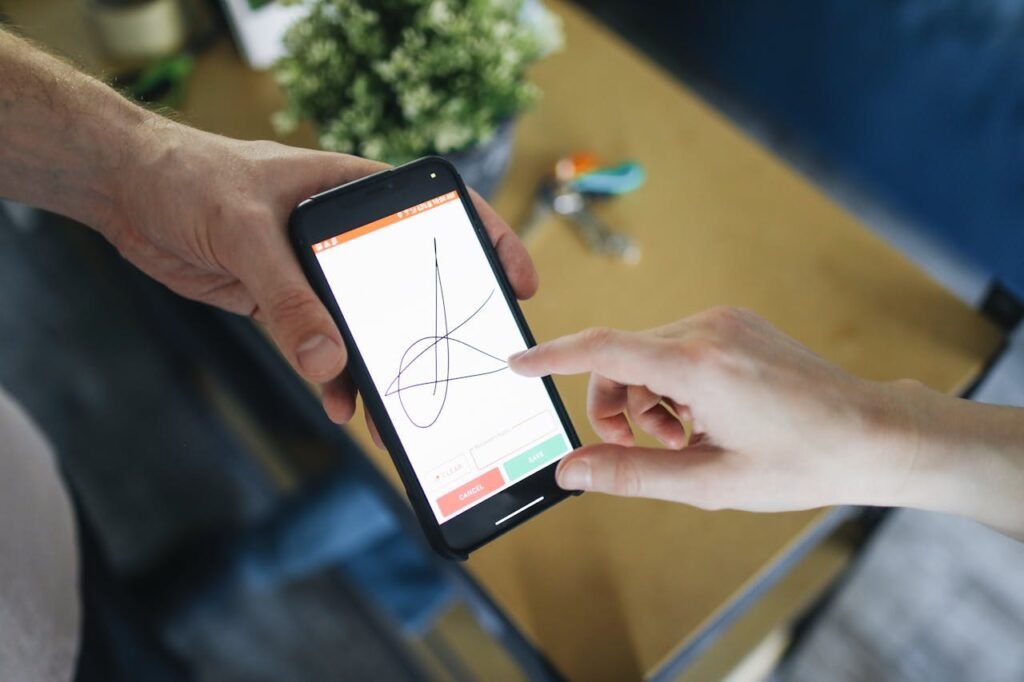
It’s easy to get caught up in the excitement of AI. But we have to pause and ask—are we building it responsibly?
At Robobionics, we believe in innovation with care. This means putting the user first—not just the technology. It means asking how this tech will affect people’s lives in the real world, not just how well it works in a lab.
That’s why we follow a simple rule: If it doesn’t help people live better, it doesn’t belong in our product.
Data Privacy and AI Learning
One of the concerns many people have with AI is data privacy. Does the prosthetic record your movements? Where does that data go? Is it stored somewhere or sent to a server?
Our answer is clear: it stays with you.
We use what’s called on-device learning. That means all the data your prosthetic collects—from how you move to how you grip—is stored locally. The AI learns from you, but it never sends your data to the cloud. You don’t need an internet connection, and nothing leaves your device.
This keeps your information safe and gives you full control over your prosthetic journey.
Avoiding Bias in AI Training
AI can only be as fair as the data it learns from. If the training data comes mostly from one group of people—say, athletes or men between 20–40 years old—then the AI might not perform well for others.
That’s why we’ve worked hard to collect diverse data during development—across different age groups, genders, occupations, and levels of physical strength. Our goal is not just smart AI, but fair AI.
We test across real-world situations: a schoolteacher writing on a board, a farmer lifting a crate, a child learning to zip their bag. The wider the testing base, the better the AI can serve everyone.
Making AI Optional, Not a Burden
Another part of ethical design is giving users a choice. Not everyone wants advanced AI right away. Some people just want a simple, dependable hand they can trust.
That’s why we design layers into our technology. The base models of Grippy Mech Finger are simple and intuitive. The AI features are optional and can be added or fine-tuned later. This gives the user control over their learning curve—and their budget.
Smart doesn’t have to mean complicated. And powerful doesn’t have to mean overwhelming. That’s the balance we work hard to maintain.
The Big Picture: How AI Can Transform Lives in Rural India
A New Kind of Access
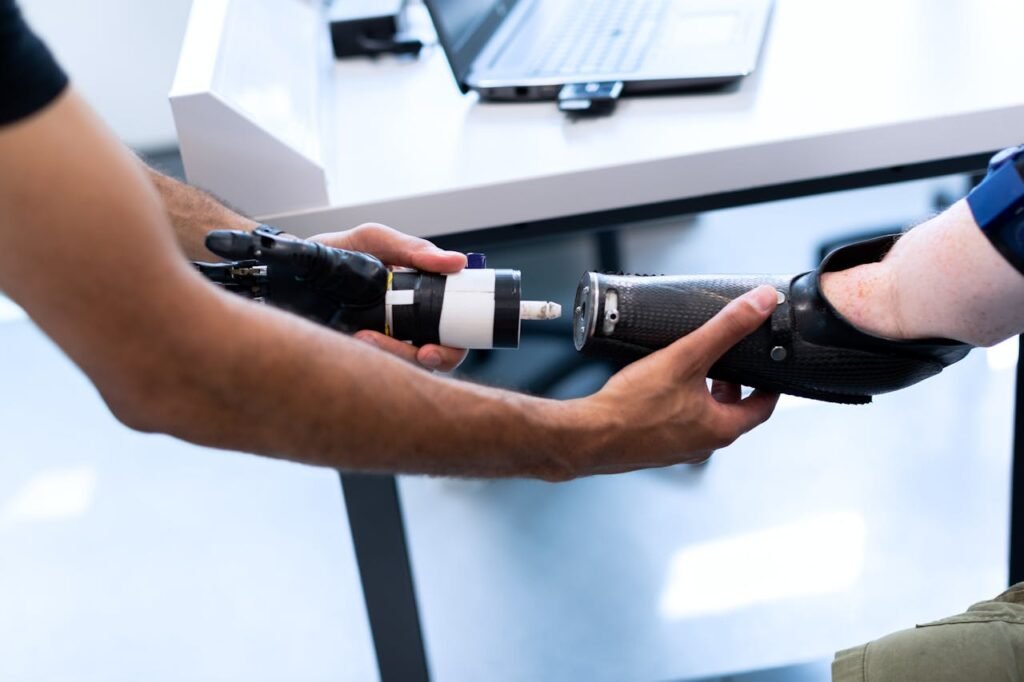
In big cities, access to smart healthcare is growing. But in villages and rural towns, prosthetic services are still rare. Many people don’t even know that affordable, high-quality prosthetics exist. And if they do, they think, “That’s not for people like me.”
We want to change that.
AI makes it possible to offer high-quality performance without needing constant in-person support. Once the prosthetic learns the user’s habits, it doesn’t need a technician nearby to make changes. That means someone living hours away from the nearest city can still get world-class care—on their own terms.
This is not a small shift. It’s a leap.
Local Manufacturing and Affordability
At Robobionics, 60 out of 64 components in our prosthetic systems are made right here in India. That’s not just a number—it’s a strategy.
Local production brings down costs, speeds up delivery, and supports the economy. It also gives us more control over quality and customization.
We use smart materials, lightweight designs, and software-based improvements to bring AI-powered features to even our most affordable models. This means a farmer, a tailor, or a student in a small town can access the same high-tech features that were once only available to elite users abroad.
We’re building smart fingers not for a few, but for the many.
Conclusion: Smarter Grip, Stronger Future
AI is no longer just a buzzword in prosthetics. It’s the quiet mind behind a stronger grip, the patient partner that learns your movements, and the reason a prosthetic finger can finally feel like part of your body—not just something attached to it.
It’s helping people not just hold things again—but hold on to dreams they thought were lost. To work without worry. To write, lift, touch, and move with confidence.
At Robobionics, we believe technology should serve people, not the other way around. That’s why our AI isn’t just smart—it’s human-centered. It listens, it learns, and it evolves with you. From the first grip to the hundredth, it gets better every step of the way.
Whether you’re a student, a teacher, a parent, or a professional—if you’re living with finger loss, you deserve a tool that understands you. That grows with you. That gives you back your strength, your freedom, your sense of self.
The future isn’t far. It’s already at your fingertips.
Ready to Feel the Difference?
If you or someone you know is ready to explore how AI can change their life with a smarter, simpler, more responsive prosthetic finger, we’re here to help.
You can schedule a free, no-obligation demo with our team. We’ll walk you through your options, help you try a device, and answer every question with care and honesty.
Book your session today at www.robobionics.in/bookdemo
Let’s build something extraordinary—together.



